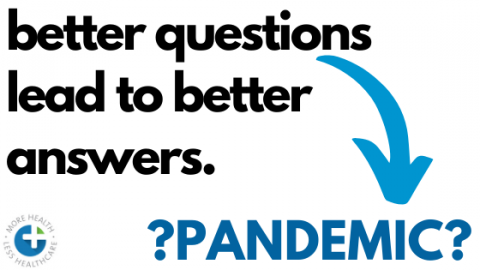
I’m not an infectious disease expert. I don’t like dealing with acute care, that’s why I love functional medicine where I can take my time putting puzzle pieces together to help a client solve their chronic illness from multiple angles.
I think functional medicine principles can help tremendously in the Corona crisis, not just from a personal health benefit but a policy assessment benefit. The biggest thing functional medicine has taught me is to ask better questions. So here is a question that has been running through my head since the media has created mass panic with the word PANDEMIC.
What is a Pandemic?
Sourced from: Doshi, P. ‘Calibrated response to emerging infections.’ BMJ 2009;339:b3471
World Health Organization (WHO)
WHO definition of influenza pandemic before 2009 A/H1N1 “pandemic”: “An influenza pandemic occurs when a new influenza virus appears against which the human population has no immunity, resulting in epidemics worldwide with enormous numbers of deaths and illness.”
WHO definition of influenza during and after 2009 A/H1N1 “pandemic”: “An influenza pandemic may occur when a new influenza virus appears against which the human population has no immunity.”
Note no mention of “enormous numbers of deaths and illness”.
Centers for Disease Control and Prevention (CDC)
CDC (Centers for Disease Control and Prevention) description of pandemic in 1997 before 2009 A/H1N1 “pandemic’: “The hallmark of pandemic influenza is excess mortality.”
CDC description of pandemic during and after 2009 A/H1N1 “pandemic”: “There are some pandemics that look very much like a bad flu season.”
Note no mention of mortality.
Canada
Canada definition of pandemic in 2006 before 2009 A/H1N1 “pandemic”: “An influenza pandemic results if many people around the world become ill and die from such a virus.”
Canada definition of pandemic during and after 2009 A/H1N1 “pandemic”: “An influenza pandemic does not necessarily cause more severe illness than seasonal influenza.”
Note no mention of mortality.
One of my mentors and scientist, Dr. James Chestnut, puts it this way.
We have changed the definition of pandemic and this alone means that a pandemic is now defined as something that is no different, or even less fatal than, a normal flu season. The word pandemic has serious fearful connotations because it is anchored to widespread severe illness and mortality. Why is this the case? Because prior to 2009 this was the definition of a pandemic.
The fact that the current outbreak of Covid-19 is already being classified as a pandemic when there is no evidence that Covid-19 is causing more deaths than regular influenza is important. This would not have been the case prior to 2009.
An important question to be answered, since a pandemic is now defined as an illness that is no worse than a normal flu season in terms of illness and mortality, is, what are the hospitalization and mortality figures in a normal flu season? The CDC reports that the annual number of people in the U.S.A. who get ill from the flu each year ranges from 9-45 million, that between 140,000 and 810,000 are hospitalized, and that 12,000 -61,000 die from the flu each year.
So, it would appear then, that to meet the criteria of pandemic, Covid-19 would have to at least equate to the worst-case scenario of an annual flu season or cause 45 million illnesses, 810,000 hospitalizations, and 61,000 deaths in the U.S.A.. Let’s keep that in mind as we evaluate the response to the Covid-19 “pandemic”.
Could COVID-19 reach those numbers? Maybe, but until they do, is the term ‘pandemic’ causing a cure that is worse than the disease?


0 Comments